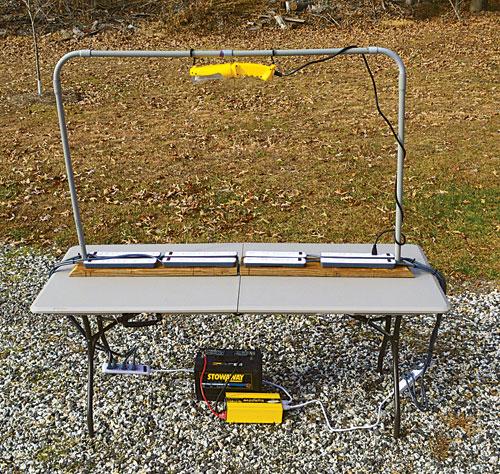 |
|
| Issue #152 • March/April, 2015 |
Many preppers are starting to realize they cannot do it all on their own. True security during a major disaster or civil unrest is much more effective if you are able to enlist the assistance of other like-minded individuals. Of course, another advantage of assisting others to become better prepared is that they will be less likely to bang on your door with empty hands when the fertilizer hits the fan.
This project is primarily intended for those of you who are already fairly well prepared with both short and long-term food storage, water storage, medical and health supplies, and some form of emergency backup power. Hopefully, you already own a portable generator and perhaps a battery inverter, and no doubt you are already familiar with setting up temporary emergency power for your home during a utility outage.
Once you have reached this level of preparedness, perhaps it’s time to consider ways you could be a real lifesaver to your neighborhood or community. Watch any news broadcast from an area just hit by a major storm and power outage some of the first things needed are bottled water and ways to recharge cell phones to contact worried relatives. While cell phones, handheld radios, and emergency walkie-talkies require very little power to recharge, the process usually takes two to four hours for each device. This could significantly limit the number of people you can help at one time regardless of the size of your power supply due to limited outlets.
This project uses eight utility outlet strips mounted on two boards hinged together at one end. When opened up, this creates two parallel rows of outlets almost six feet long which can be placed down the center of a six-foot fold-in-half table. When unfolded, the two boards become the base support for an overhead LED work light fixture hanging from a ¾-inch PVC pipe assembly. This pipe support system is easy to pull apart for disassembly and packing. When folded closed, the entire system (including the table) is less than three feet long and will easily fit in a vehicle trunk or closet. In less time than it takes to unfold the table, you can unfold the power strip and instantly have 48 outlets for charging 120VAC electronic devices, plus an additional 16 USB charging ports for charging all types of computer devices. Another advantage of this design is that everything terminates at only two plugs, which can be connected to almost any source of electrical power.
The overhead LED work light I have included hangs from the conduit support by a built-in hanger at each end, and will help draw those people in need to your immediate area. It creates plenty of illumination after dark for people waiting for their devices to be recharged. This is a perfect time to hand out bottled water and any other emergency supplies you may have. Typically, it takes several days before major relief organizations are able to get organized and arrive in force at a disaster area, so during the first few days when there is limited outside assistance, your ability to get there fast and recharge hundreds of cell phones and distribute bottled water can be a real lifesaver.
You may be called upon to recharge battery-powered devices for people who have lost everything and no longer have their charger or cable. This may require rearranging several adapters and cables in different configurations under less than ideal conditions to make this happen. The following outline should help you get started.

Recommended outlet strip
Power source
If you do not already own a small generator or battery-powered inverter, you will need one or the other to power this charging station. Most low-cost generators have limited voltage regulation; while they may be able to power incandescent lights and power tools, some do a very poor job powering electronic equipment. Many manufacturers will add a small “i” after the model number to indicate any generator model that includes “inverter quality” voltage regulation and is safe to power electronic equipment. The 1000i Honda generator which I used for this project is a good fit for this particular battery charging application as it is quiet, small, lightweight, and will run up to 10 hours on a single tank of gas. Unfortunately, I have found it to be a little underpowered and will trip the circuit breaker whenever the load gets anywhere close to the 1000-watt rating. I think the Honda 2000i might be a better choice, as the 2000-watt rating is double the smaller model wattage rating, yet its weight, size, and price are only slightly higher than the 1000-watt model.
An inverter in the 700 to 1000-watt range should provide enough power for this portable cell phone charging station using a deep-cycle RV/marine battery. Most inverters in this size range will be advertised as either a “modified” or “pure” sine wave inverter. A 700-watt modified sine wave inverter will cost $65 to $95, depending on brand and features, while a pure sine wave inverter the same size will cost $180 to $220, also depending on brand and features. The lower-priced modified sine wave inverter should be acceptable for powering cell phone chargers and similar devices. However, if you plan on also using this inverter at home to power your own loads during an outage, I think you will find the pure sine wave inverter will provide better performance and at a higher efficiency, especially for the more sensitive electronic devices.
When it comes to assisting neighbors and even strangers to recharge their cell phones and small electronic devices, many may come to your portable charging station with only the discharged device. This means that in order to help the most people, you should have a few cell phone chargers, USB cables, and plug adapters on hand. Most of the cell phones and electronic devices you will be asked to recharge will require very little power for the recharging process. However, since most of these devices may have a totally dead battery, it could take two to four hours to fully recharge each device. This is why I have included a large number of outlets and USB ports so you will not have large groups of people waiting hours for their turn to use a very limited number of outlets or extension cords.
Although most cell phone chargers are designed to plug into a 120VAC wall outlet, more and more chargers today have standardized on using a removable cable with a flat USB type connector. This allows the cell phone charging cable to be connected to multiple types of separate chargers and even the USB connector port on a computer.

Above: Outlets with wrong orientation
Below: Outlets with correct orientation

What can your system recharge?
Of course, just having a bunch of power outlets and extension cords does not mean your system can power refrigerators, microwave ovens, and big screen televisions. This basic emergency power system with a 700 to 1000-watt inverter and 12-volt deep-cycle RV/marine battery is sized only for recharging a reasonable number of cell phones and small electronic devices during a major power outage.
A group 27 deep-cycle battery will weigh approximately 51 pounds and have a 85 to 95 amp-hour rating (at a five-hour discharge rate) depending on brand. A group 31 deep-cycle battery will weigh approximately 61 pounds and have a 95 to 105 amp-hour rating (at a five-hour discharge rate) depending on brand. I never recommend allowing any deep-cycle battery used in an off-grid application to be discharged more than 50% in order to maximize battery life. However, since this is a critical emergency power supply that may need to operate under more extreme conditions only a few times per year, I will assume a 80% discharge level is acceptable.
If a group 27 RV/marine battery is used, this would provide 76 amp-hours of useful battery energy (95 x 0.80). I recently took a number of cell phones, iPads, and hand-held radios and measured with a lab-calibrated kilowatt-hour (kWh) meter exactly what it took to recharge these devices after I completely discharged them. I was somewhat surprised to learn how many of these devices drew very little power during the recharging process, but most still took up to four hours to fully recharge.
Since battery capacity is normally given in amp-hours and not kilowatt-hours, we need to first convert one or the other measurements into the same terms before we can estimate total system recharge capacity. Our above calculation of 76 amp-hours of battery capacity will be between 12 volts when almost discharged, and more than 14 volts when fully charged. Using 13 volts as a rough estimate of the average battery voltage during inverter operation, this gives us approximately 1 kWh of available energy in the battery (76 x 13), not including efficiency losses. It took 0.02 kWh to fully recharge my Galaxy 4G cell phone which includes Internet, Wi-Fi, and Bluetooth features. It took 0.06 kWh to fully recharge my iPad 2, and 0.015 kWh to recharge a very basic cell phone. This gives us a theoretical capacity of recharging 50 cell phones, or 16 iPads from a single group 27 deep-cycle battery.
Of course, actual recharge capacity could be less than these estimates since inverters not only have an efficiency loss, but also increase battery amp draw as the battery voltage starts to drop. It’s also possible that some cell phones and handheld radios needing to be recharged may have a much smaller power draw, which would increase the total number that could be recharged. You could use battery cables from your vehicle to recharge the inverter battery while it is providing recharging services. It’s also possible that if faced with multiple days of power outages and a long line of discharged cell phones, you could switch to a small generator to power the outlet strips and light(s) as long as fuel is available. You could even use a fold-out portable solar array to help recharge the inverter’s battery.

Hinge installed on back side of boards
Materials
I’m sure many readers will already have most of the materials needed to build this project just lying around their garage or junk bin. The one exception is the eight identical outlet strips. Assuming you head to the store without my materials list, you may be faced with choosing between many different outlet strip models on display while wondering which model is best for this application. Please do not grab a handful of the cheap $6 all-plastic outlet strips from the discount bin, as these are intended for connecting devices having small plugs. They are not designed for plugging in multiple cell phone and electronic device chargers, which are much larger.
Materials list:
- Eight Utili-Tech 6-outlet surge protectors (w/USB)
- Two Utili-Tech 6-outlet surge protectors (no USB)
- One Bayco LED work light with front and rear hangers
- One Styleselections fold-in-half 6-foot table
- Two ¾” PVC 900 sweep fittings
- One ¾” PVC pipe coupling
- Two ¾” PVC conduits x 10 feet
- One 6-foot-long 2×6 board (cut in half)
- One 3″ hinge
The eight outlet strips selected for this project cost $16 each and have several design features that are perfect for this application. Notice the outlets are oriented to the side, which accommodates chargers having cords coming out their end which will not interfere with any adjoining chargers. These outlet strips also include two USB charging ports that provide 5 volts DC of charging power which can directly charge most cell phones and computer devices that have the correct adapter cable. In addition, these outlet strips include both a surge suppressor which can block voltage spikes from power sources like unregulated generators, and also an electronic “noise” filter. This filter reduces power quality issues that can affect sensitive electronic devices. While I’m sure there are many other brands and styles of outlet strips you can find, just be sure to select the outlet strips that incorporate the features I have described.
In addition to the eight filtered utility strip outlets you will be mounting on the 2 x 6 boards, you will need two less-expensive unfiltered strip outlets. One of these will be located at each end below the table, providing an easy way to combine all power cords from the eight mounted strip outlets into two plugs that connect to either a small generator or battery inverter.
In the photos, you can see the difference between the incorrect and correct strip outlets for this application. Each outlet is very close together in the cheaper outlet strip shown on the left, which does not allow enough space to accommodate a charger device. This outlet strip also has its outlets oriented lengthwise, which will accommodate fewer plug-in chargers than outlet strips oriented towards the side. Some of the more expensive outlet strips have a metal case with outlets separated by an inch or more of space; they are also a good choice. They are intended for connecting multiple devices having wall transformers or charger devices that would normally cover up closely spaced adjoining outlets.

Front side of boards showing eight outlet strips installed
Assembly
To assemble the system, first cut the six-foot 2×6 board in half, then cut a 45° bevel at one end of each board. Each board should now be 34-35″ long to accommodate the eight strip outlets. You will then need to drill a 11/16″ diameter hole near the bevel cut at each end to support the vertical ¾” PVC pipe support.
Next, attach the hinge on the back side of the two boards, which is opposite the side where you will mount the outlet strips. Be sure to note which way the bevel is cut in reference to the hinge side by referring to the photos. Although the outlet strips have provision on their bottom side to mount with screws, I decided to use contact cement which made the entire process easier and quicker. I used a sander to rough up the bottom of each outlet strip to provide a better bond to the wood. My first attempt to bond the outlet strips to the wood without first roughing the bottom surfaces was less successful.
Coat the top surface of each board and the bottom surface of each outlet strip with a quality contact cement, but keep separate until all surfaces are ready to press together per the glue manufacturer’s drying time instructions. Position each strip outlet just above each board, but be careful because as soon as you make contact they cannot be repositioned. I placed each outlet strip along the edge of the boards and as far apart as possible to provide enough space to route their power cords.
When cutting and assembling the PVC parts, be careful to not glue everything together as you want to be able to disassemble everything into a small package for transport. I glued one upright to each 90 degree bend. The socket end of the bend was not glued so that the horizontal conduit sections can be removed for disassembly. I glued the ¾” coupling to only one of the horizontal conduit sections which also allows easy disassembly. All of these materials cost me less than $180, including the six-foot table.

Completed and folded recharge station
Citizens Assisting Citizens: A volunteer organization
Now that you have completed your own emergency recharging station, please consider joining an organization that will give you plenty of opportunities to use it for helping others during the next power outage or a nearby disaster.
Being able to help your neighborhood or a nearby community during a major power outage is certainly rewarding, but if you want to take this community service to the next level, consider joining Citizens Assisting Citizens (CAC). First promoted two years ago by Jack Spirko in his daily “Survival Podcast” Internet radio show, the CAC is headed up by Tom Patterson. This national non-profit association provides a more formal recognition for your emergency assistance efforts, along with a substantial network of backup support. Please note, a background check is required to join. As a member, you are supplied with official identification and magnetic signage for your vehicle. This makes it much easier to pass through police barricades that typically block access to most disaster areas.
This association has arranged for buying emergency supplies from several national chains with outlets in most cities. A debit card is issued to each member, which will be activated if you’re called upon to purchase supplies and head to an area near you where the association has requested your immediate assistance. Members are also given a substantial amount of emergency equipment for their vehicles to get started, and web-based training programs are also offered.
With members located all across the United States, chances are high that several will be living only a few hours’ drive from any disaster area, and can pick up any needed supplies on their way using the debit cards. Members will hand out free water and snack crackers, and will provide cell phone charging services during those first few hours or days until the major relief agencies arrive, so members are not expected to provide emergency medical services or get involved with actual rescue efforts. Other CAC members will be staged to provide re-supply based on your status reports, and can relieve anyone who cannot stay longer. This is an all-volunteer national organization with no paid staff, so all donations go towards purchasing emergency supplies and equipment. If you would like more information about joining this organization, or would like to donate, please go to the following web site: www.cacteam.com.
[weaver_widget_area id=’articles_about_yago’ class=’text3′]














